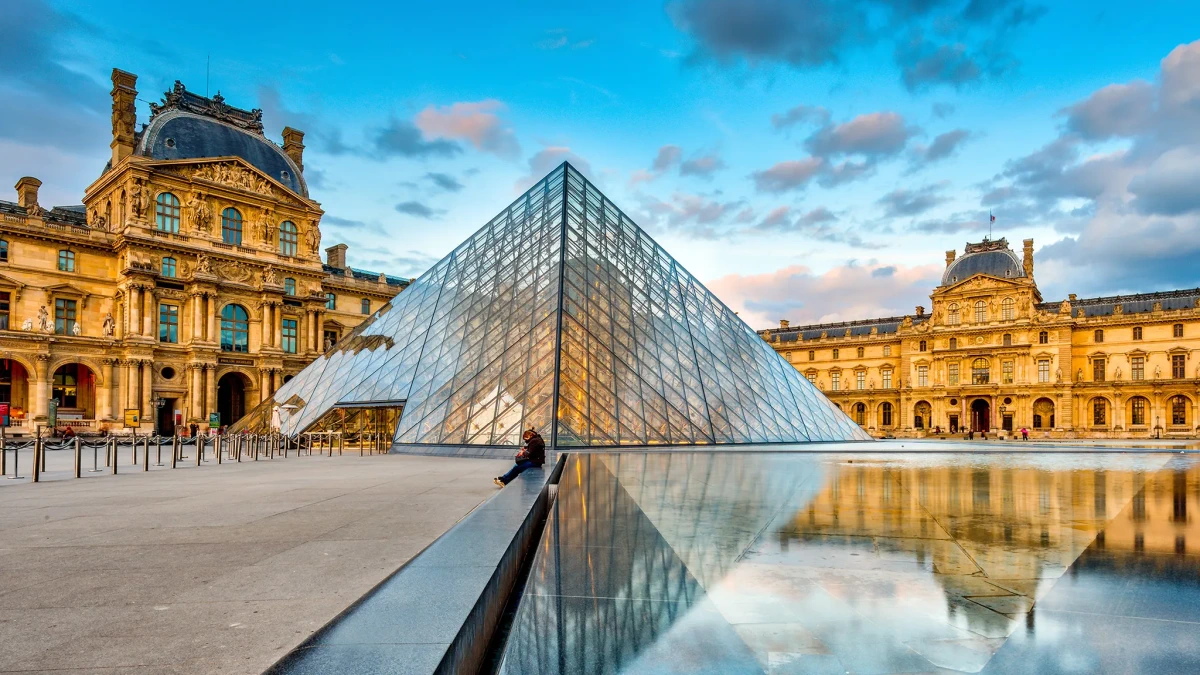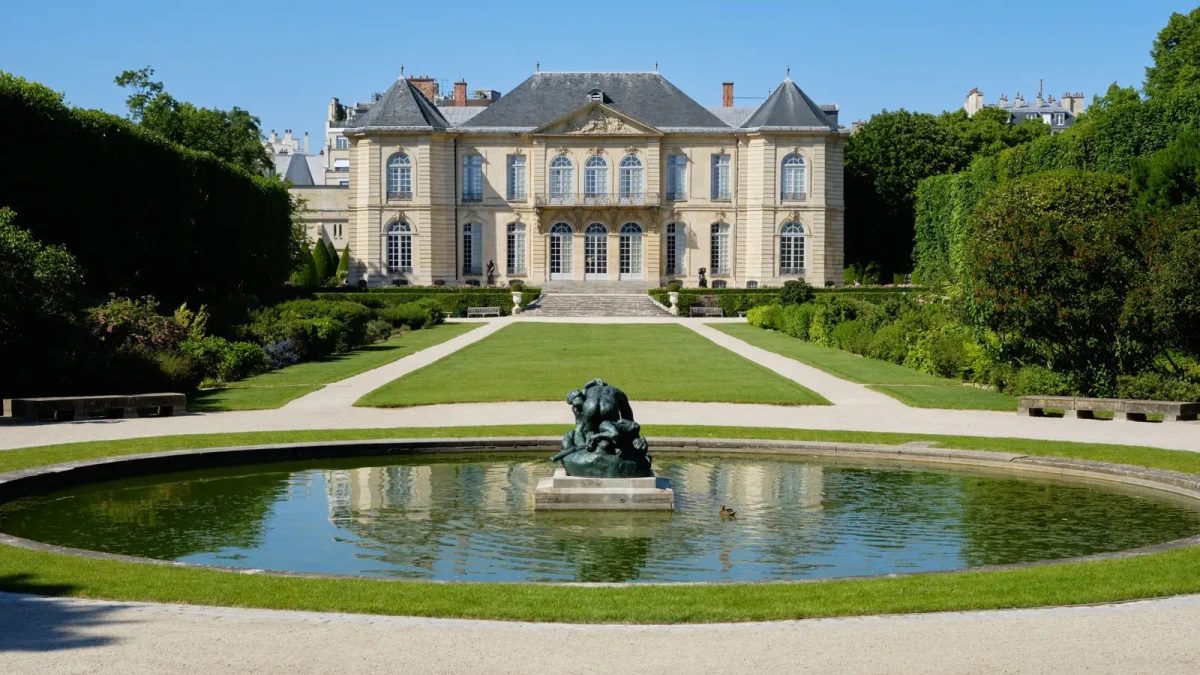The Louvre Paris, originally built as a fortress in the 12th century, has transformed over the centuries into a palace and eventually a museum. Its architecture itself is a work of art, with its glass pyramid entrance contrasting the classic French Renaissance style of the main building. From its humble origins to its current status as the world's largest art museum, the Louvre's history is as captivating as the artworks it houses.
Note: This article contains affiliate links. In case you purchase something through one of these links, we may receive a small commission at no extra cost for you. Thank you for helping us keep creating the free content on this website!
Introduction to Louvre Paris
The Louvre Paris is a renowned cultural institution nestled along the Seine River in the heart of Paris. Originally a medieval fortress, it transformed over the centuries into a majestic palace and eventually became a public museum in 1793, marking a pivotal moment in cultural accessibility. With a collection spanning over 9,000 years of human history, the Louvre houses a diverse array of artworks and artifacts.
From ancient Egyptian sculptures to Renaissance masterpieces, the museum offers a remarkable journey through time, connecting visitors with the stories, emotions, and cultural heritage of different eras. The Louvre's iconic glass pyramid entrance juxtaposes modernity with history, and its architecture adds to the experience of exploring its extensive corridors and galleries.
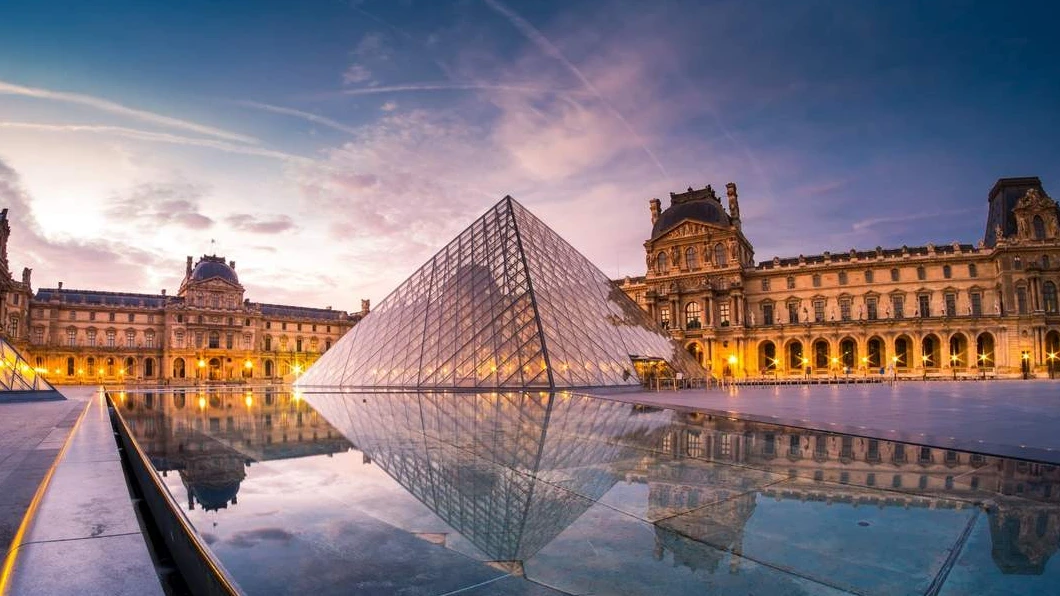
The museum is home to world-famous pieces such as Leonardo da Vinci's "Mona Lisa," but its treasures extend far beyond this iconic work. As a sanctuary of art and inspiration, the Louvre invites visitors to contemplate, connect, and be captivated by the profound impact of human creativity and expression.
The pyramid's transparent structure allows natural light to filter into the underground lobby, serving as a metaphorical bridge between the world above and the treasures below.
The History of The Louvre Paris
Began as a medieval fortress has evolved into one of the world's most iconic and visited museums, an institution that not only houses a vast collection of art and historical artifacts but also represents a symbol of cultural heritage and human creativity.
The origins of the Louvre Paris can be traced back to the 12th century when King Philippe Auguste commissioned the construction of a fortress to protect Paris from potential Viking invasions. This initial structure, located on the right bank of the Seine River, laid the foundation for what would later become the Louvre Museum.
What Over the centuries, the Louvre underwent significant expansions and modifications, reflecting the changing needs and ambitions of the French monarchy. It was during the Renaissance that the Louvre transformed from a fortress into a grand palace, with King Francis I commissioning the addition of elegant wings and galleries. The artistic patronage of subsequent monarchs contributed to the growth of the palace, turning it into a hub of cultural and political activity.
In the 17th century, King Louis XIV moved the royal residence to the Palace of Versailles, marking a shift in the Louvre's purpose. The palace continued to house art collections and served as a repository for the royal collections. However, it wasn't until the French Revolution in the late 18th century that the Louvre's fate took a dramatic turn.
The revolutionaries seized the Louvre and transformed it into a public museum, officially opening its doors as the Musee Central des Arts in 1793. This groundbreaking decision marked a departure from the exclusive confines of royal ownership, opening up the treasures of the Louvre to the general public. The museum's mission expanded beyond a repository of art; it became a symbol of enlightenment, accessibility, and cultural heritage.
Under Napoleon's rule, the Louvre continued to expand its collection through both conquests and acquisitions. The era saw the addition of numerous artworks from across Europe, many of which are now considered integral to the museum's identity. The Louvre's status as a global cultural institution was solidified during this time.
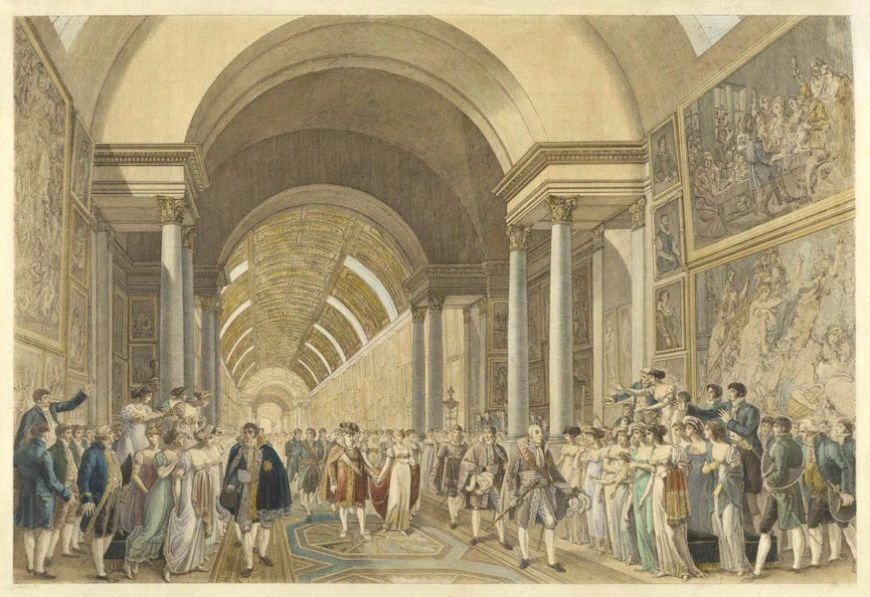
The 19th and 20th centuries witnessed further transformations, with expansions and renovations aimed at accommodating the growing collection and accommodating the needs of modern audiences. One of the most iconic additions is the glass pyramid entrance, designed by architect I. M. Pei and inaugurated in 1989. This modern juxtaposition against the classical architecture of the Palais du Louvre captured the spirit of the institution's evolution.
Today, the Louvre Paris stands not only as a repository of art but as a symbol of Paris itself. Its collection spans millennia, offering visitors an unparalleled journey through human creativity, history, and cultural diversity. From iconic pieces like the "Mona Lisa" to lesser-known but equally captivating treasures, the Louvre continues to inspire awe, curiosity, and a deep connection to the past.
The Louvre's history is not just a chronicle of architectural changes or acquisitions; it's a testament to the evolving relationship between art, society, and accessibility. Its transformation from a fortress to a palace to a public museum reflects the changing values of a society that recognizes the universal importance of cultural heritage and creative expression.
If you were to spend eight hours every day in the Louvre to see every exhibit for just 30 seconds, it would take 36 days.
Masterpieces Beyond Measure
One of the Louvre's most enchanting aspects is its unparalleled collection of masterpieces that span various artistic movements and eras. From the ancient civilizations of Egypt, Greece, and Rome to the Renaissance and beyond, the Louvre Paris boasts an unrivaled assortment of artifacts that tell the story of human civilization.
The Louvre's collections are categorized into eight departments, each housing a unique range of artworks and historical pieces and each specializing in different areas of art and history. As of my last knowledge update in September 2021, here are the eight main departments of the Louvre:
- Paintings: The Paintings department holds the famous collection of European paintings, including masterpieces like the Mona Lisa and works by artists such as Leonardo da Vinci, Rembrandt, and Vermeer.
- Sculptures: This department focuses on European sculptures from the Middle Ages to the 19th century, featuring works by famous sculptors like Michelangelo and Rodin.
- Decorative Arts: It includes a diverse collection of decorative objects, furniture, ceramics, and glassware from various time periods and styles.
- Egyptian Antiquities: It features an extensive collection of ancient Egyptian art and artifacts, including mummies, sculptures, and jewelry.
- Near Eastern Antiquities: This department houses artifacts from the ancient Near East, including Mesopotamia, Persia, Anatolia, and the Levant.
- Islamic Art: The Islamic Art department showcases art and objects from the Islamic world, including ceramics, textiles, and manuscripts.
- Greek, Etruscan, and Roman Antiquities: This department contains classical art and artifacts from ancient Greece, Etruria, and the Roman Empire.
- Prints and Drawings: This department houses an extensive collection of prints, drawings, and illustrated books from different periods and regions.
Please note that museum departments and their collections may evolve over time, so I recommend checking the official Louvre Museum website or contacting the museum directly for the most up-to-date information on their departments and collections.
1. The Paintings in The Louvre Paris
Among its vast and diverse collection, the museum houses a remarkable array of paintings that span centuries and encompass various artistic movements. Here, I will highlight some of the most iconic and celebrated paintings found within the hallowed halls of the Louvre. These are just a few of the countless treasures found in the Louvre's vast collection. The museum's paintings offer visitors a unique journey through the history of art, from ancient civilizations to the most recent artistic innovations. The Louvre Paris is not just a repository of art; it's a testament to the enduring power of creativity and human expression.
#1 The Enigmatic Smile: Mona Lisa
Perhaps the most renowned painting in the world, the "Mona Lisa" by Leonardo da Vinci, captivates audiences with her enigmatic smile and captivating gaze. Housed within a secure, climate-controlled chamber, this masterpiece draws hordes of admirers, all eager to catch a glimpse of the mysterious woman who has captivated hearts for centuries. The "Mona Lisa" is not merely a portrait; it's a symbol of the timeless fascination humans have with the mysteries of life and the depth of human emotion.
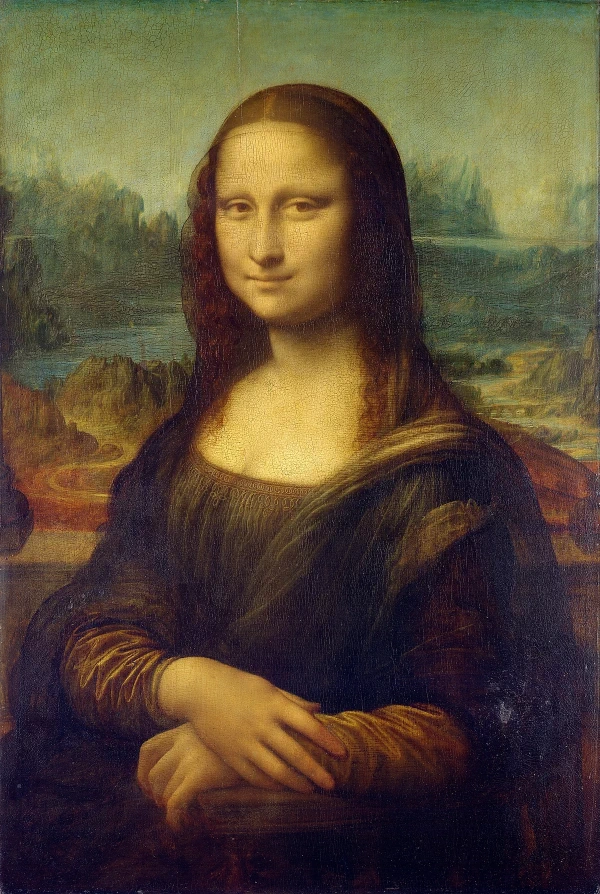
#2 The Raft of the Medusa by Théodore Géricault
This colossal Romantic-era painting vividly portrays the aftermath of a shipwreck. Géricault's use of light and shadow, as well as the dramatic composition, evoke a sense of despair and hope, making it a striking work of art that's impossible to ignore.

#3 Liberty Leading the People by Eugène Delacroix
A symbol of the July Revolution of 1830 in France, this painting captures the spirit of liberty and revolution. Delacroix's dynamic composition and vibrant colors make this Romantic masterpiece a potent representation of the ideals of freedom and democracy.
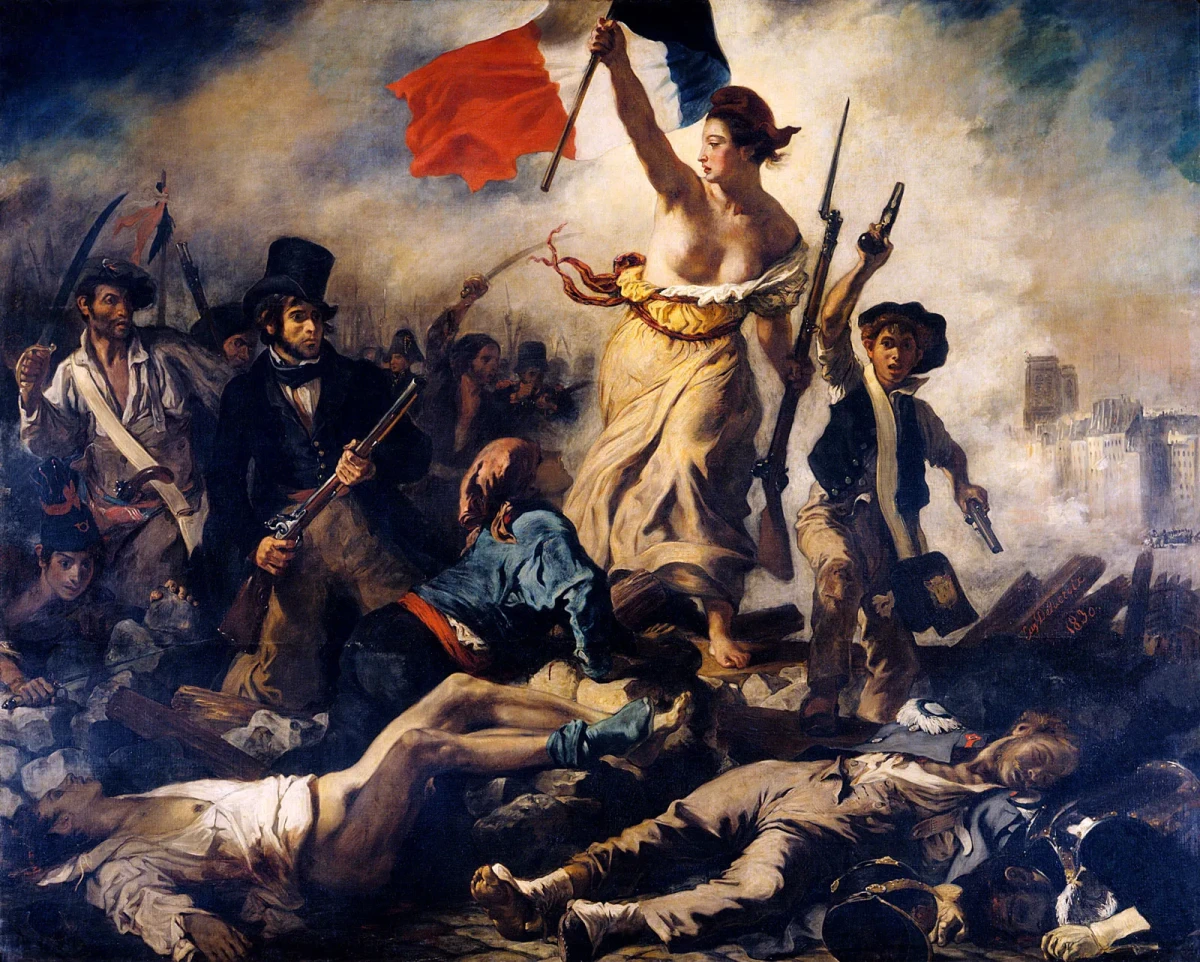
#4 The Wedding at Cana by Paolo Veronese
This enormous painting showcases a biblical scene where Jesus performed his first miracle by turning water into wine at a wedding feast. Veronese's meticulous attention to detail, sumptuous colors, and the grandeur of the composition make it a masterpiece of Venetian Renaissance art.
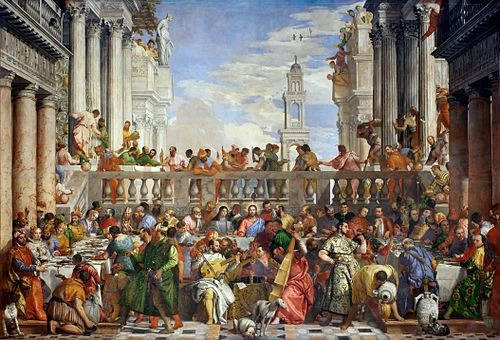
#5 The Lacemaker by Johannes Vermeer
A masterpiece of Dutch genre painting, this intimate portrayal of a young woman engaged in the act of lacemaking is a testament to Vermeer's mastery of light and his ability to capture everyday moments with exquisite precision and grace.
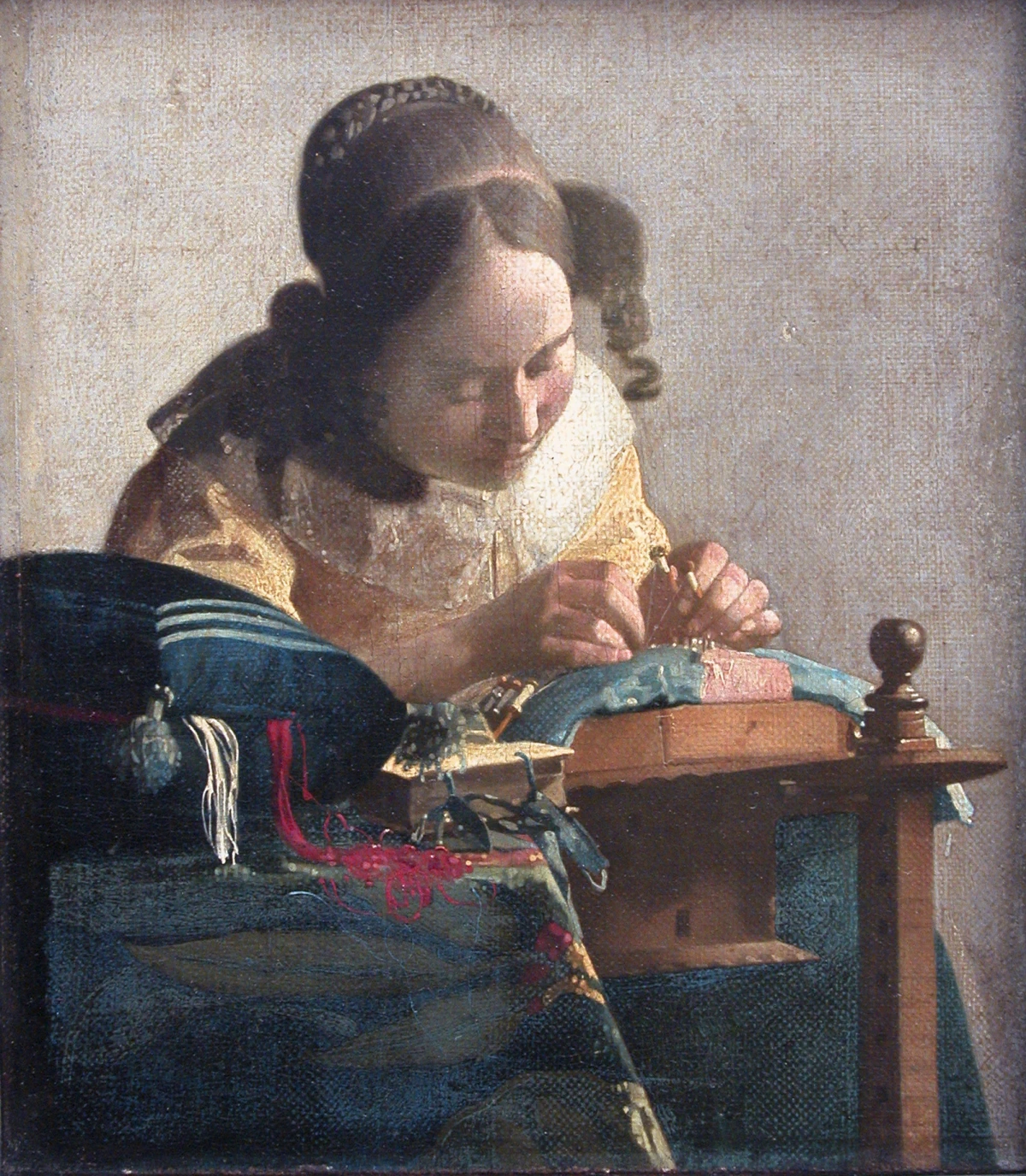
#6 The Consecration of the Emperor Napoleon I and the Coronation of Empress Joséphine in Notre-Dame Cathedral by Jacques-Louis David
This monumental neoclassical painting immortalizes the crowning of Napoleon Bonaparte as Emperor of the French in 1804. It's a grandiose representation of power and authority, with meticulous attention to historical accuracy.
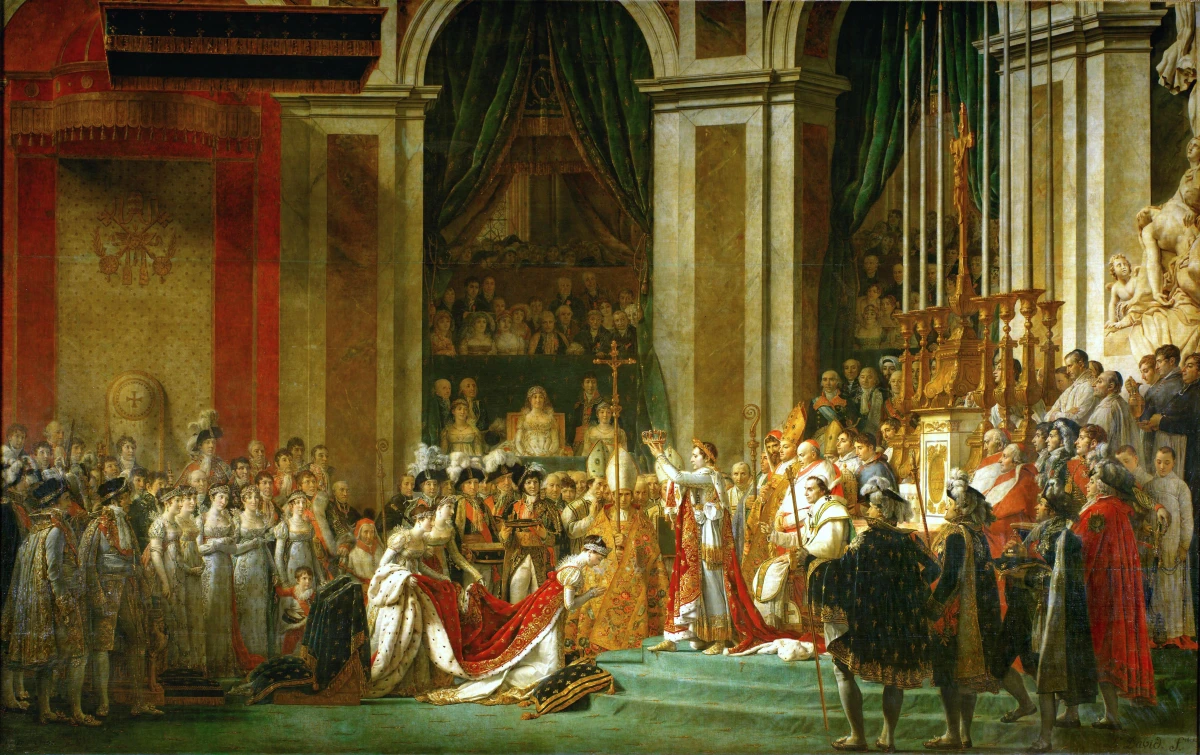
#7 The Death of Sardanapalus by Eugène Delacroix
Another powerful work by Delacroix, this painting depicts the gruesome scene of the Assyrian king Sardanapalus taking his own life as his empire falls. The fiery colors and frenetic energy in the composition exemplify the Romantic movement's passion and emotion.
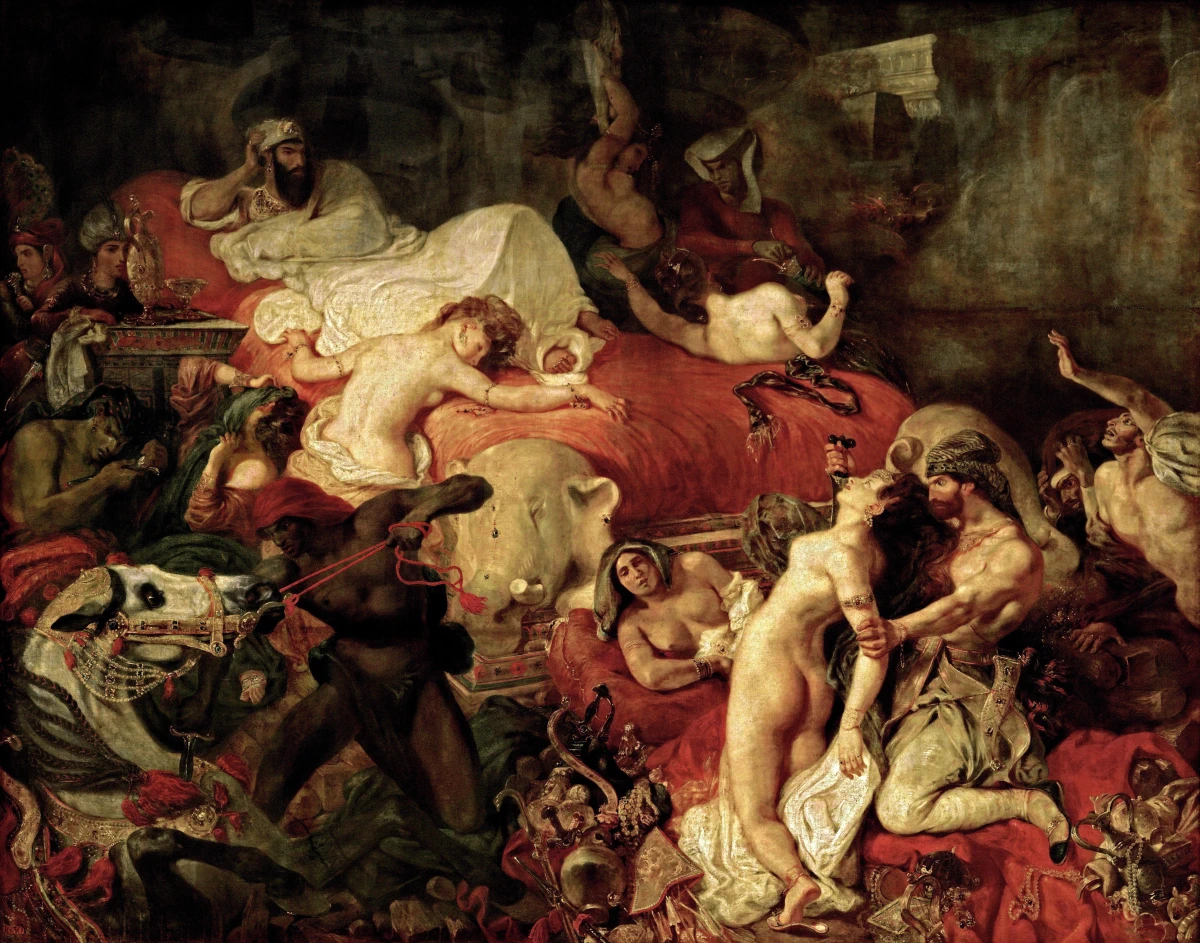
2. Sculptures in The Louvre Paris
The Louvre Museum in Paris is renowned not only for its exceptional collection of paintings but also for its extensive and remarkable sculpture collection. These sculptures, spanning centuries and diverse styles, offer a captivating journey through the evolution of sculptural art. Among many other sculptures in the Louvre Paris, showcase the rich tapestry of artistic styles and historical periods that the museum's collection encompasses.
Each sculpture tells a story, captures a moment in time, or embodies the ideals of its era, making the Louvre a treasure trove of sculptural art and a testament to the enduring power of human creativity. Here are some of the most notable sculptures housed within the Louvre's hallowed halls:
#1 Venus de Milo (Aphrodite of Milos)
In the realm of sculpture, the "Venus de Milo" stands as a testament to the grace and beauty of ancient Greek art. This exquisitely carved marble statue of the goddess of love and beauty, dating back to around 100 BCE, exudes an aura of timeless elegance. With her missing arms adding an air of mystery, the statue's graceful posture and delicate features have fascinated art enthusiasts for generations, embodying the idealized form of feminine beauty in classical antiquity.
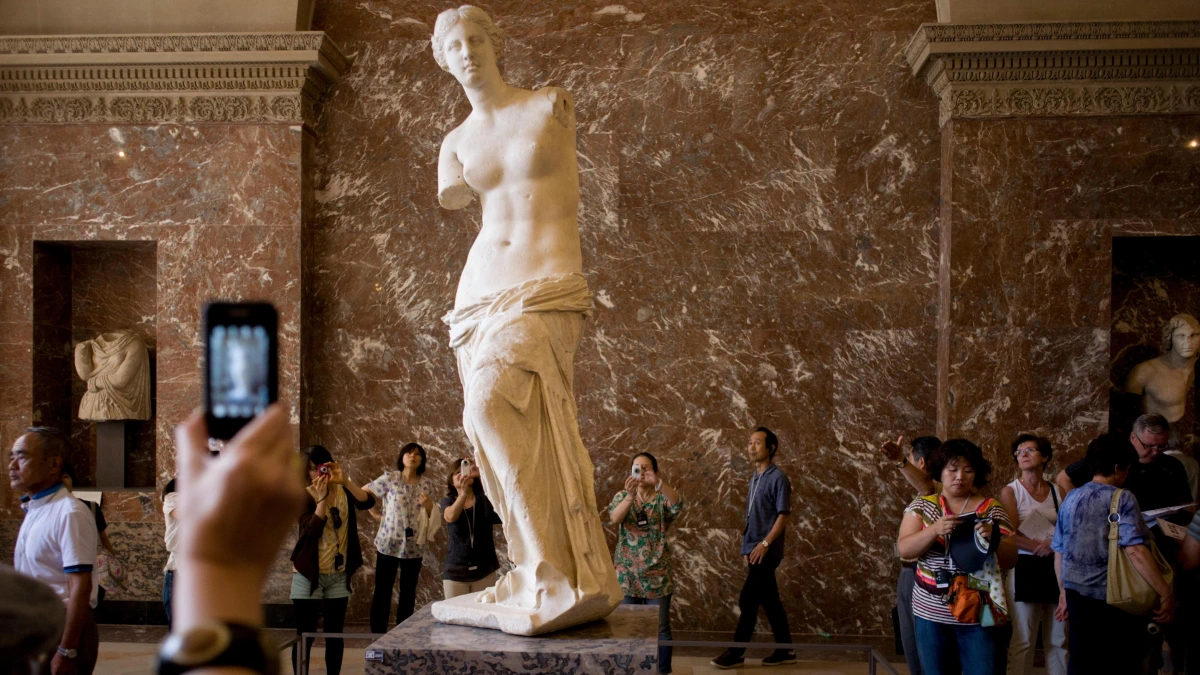
#2 Winged Victory of Samothrace (Nike of Samothrace)
Perched atop a grand staircase, this Hellenistic sculpture from the 2nd century BC depicts Nike, the Greek goddess of victory, in a dynamic pose. Her outstretched wings and billowing garments capture a sense of motion and triumph, making it a symbol of victory and freedom.
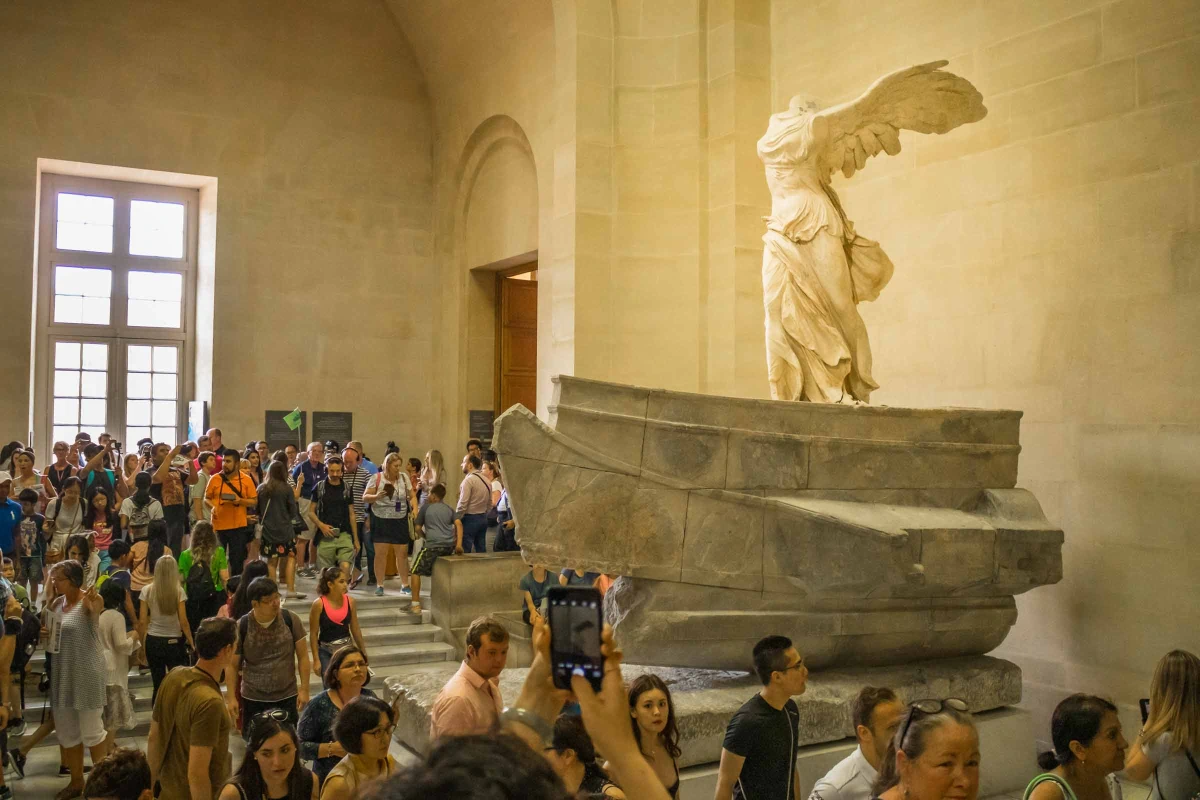
#3 The Dying Slave and The Rebellious Slave by Michelangelo
These two sculptures are part of a series created by the Italian Renaissance master Michelangelo for the tomb of Pope Julius II. The Dying Slave and The Rebellious Slave showcase Michelangelo's unparalleled skill in conveying the human form and emotion, even in the uncompleted state in which they remain.
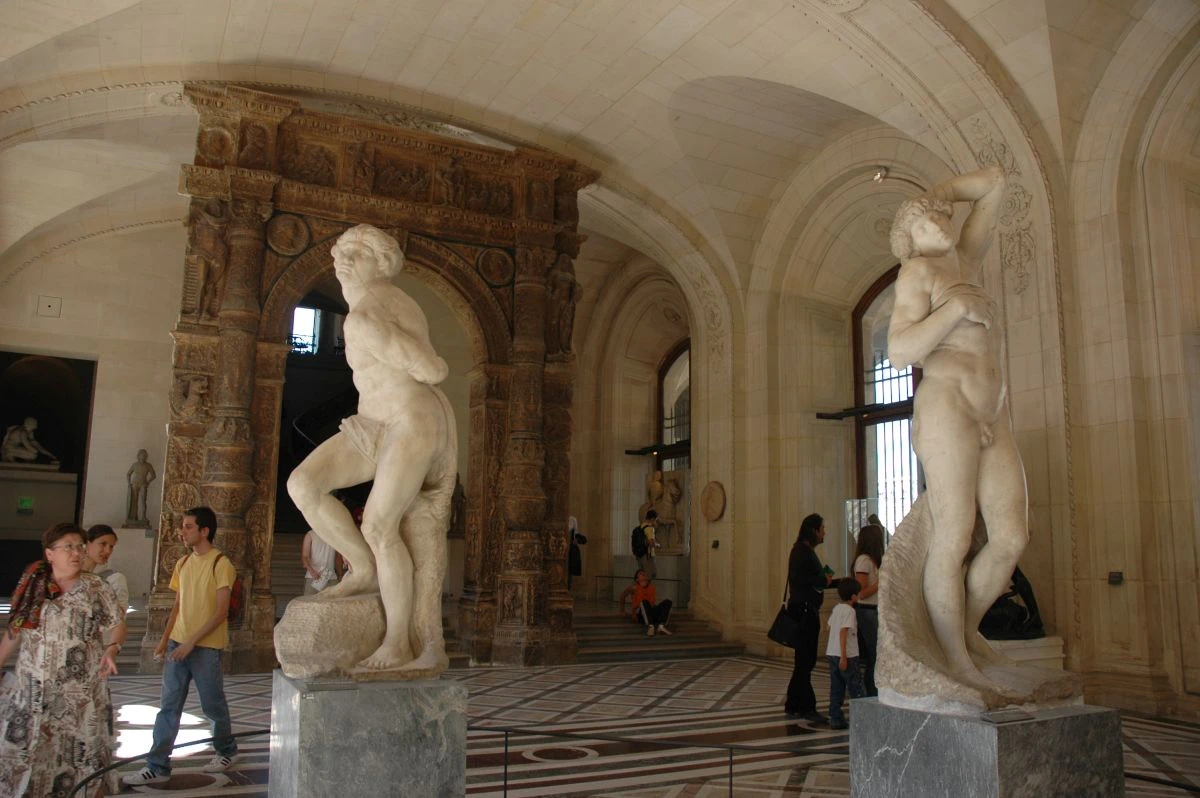
#4 Psyche Revived by Cupid's Kiss by Antonio Canova
This neoclassical masterpiece depicts the mythological story of Psyche and Cupid. Canova's sculpture captures the tender moment when Cupid revives Psyche with a kiss, blending sensuality with classical aesthetics. The exquisite details and the emotional depth of the figures make it a highlight of the Louvre's collection.
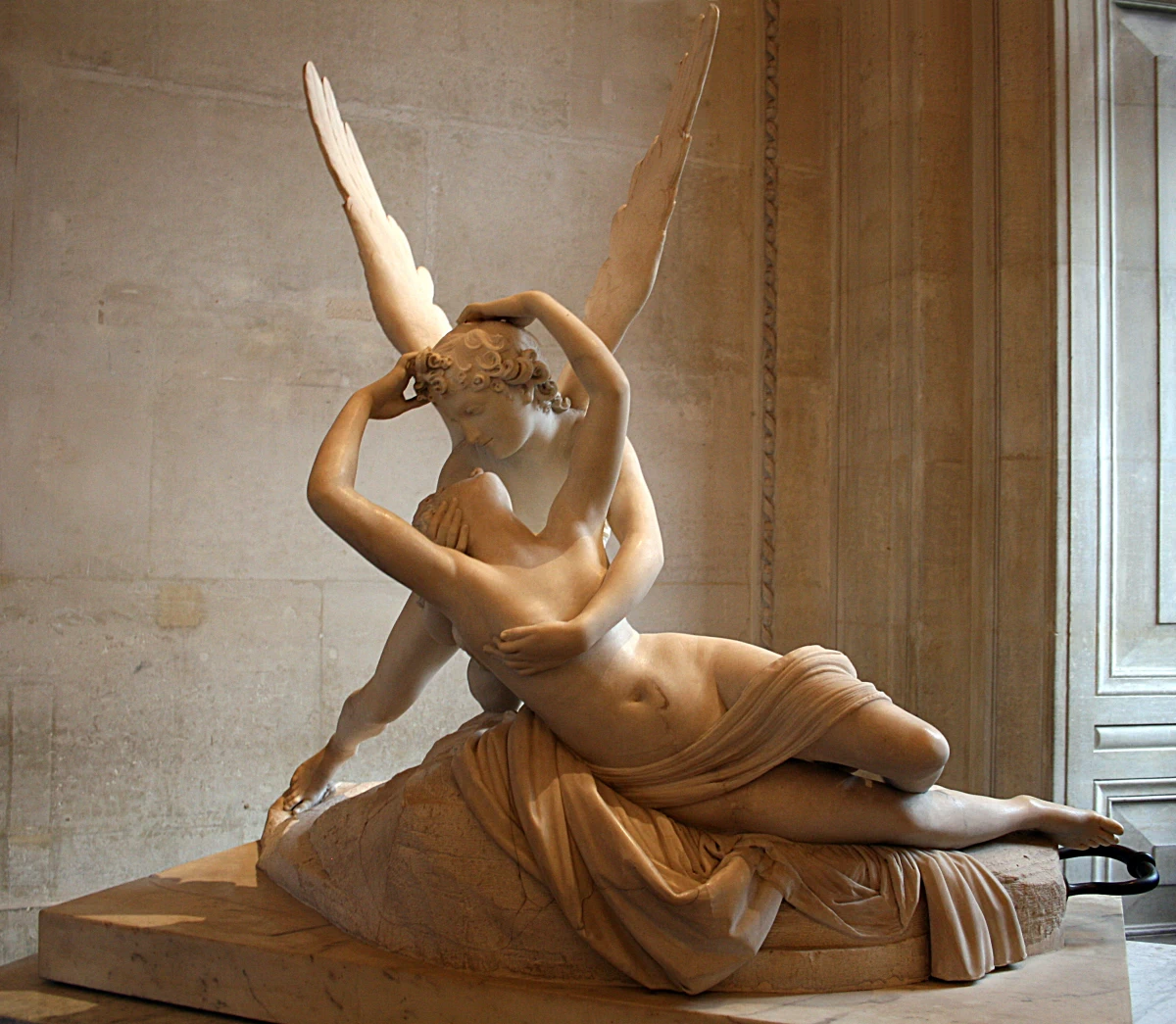
#5 The Three Graces by Antonio Canova
Another work by Canova, this sculpture presents the three Charites from Greek mythology, representing beauty, charm, and joy. Canova's skillful rendering of the female form and the delicate intertwining of the figures make this a quintessential example of neoclassical sculpture.
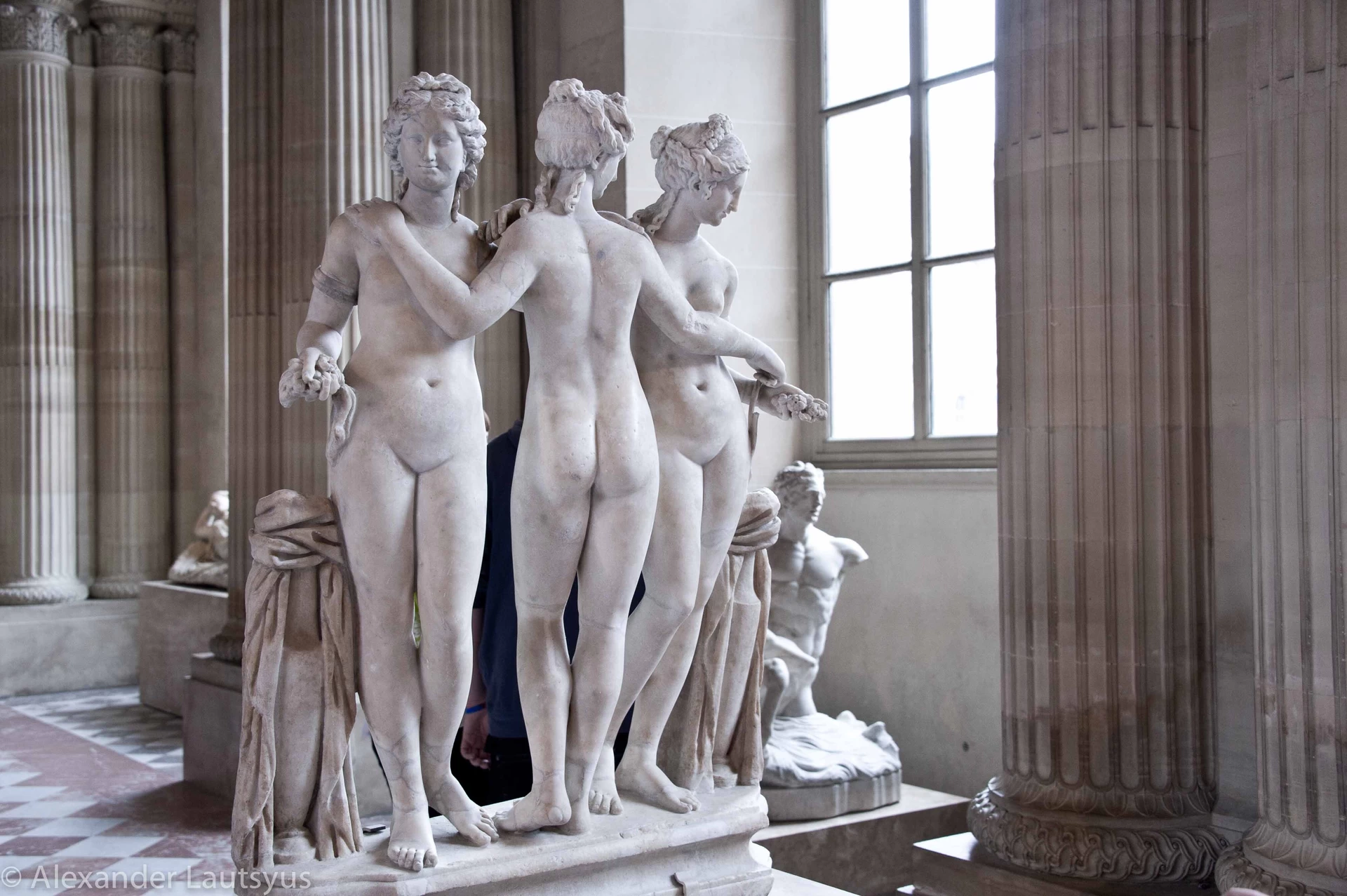
#6 The Sphinx of Tanis
This colossal Egyptian sculpture is a granite representation of a sphinx, a mythical creature with the body of a lion and the head of a pharaoh. Dating back to the 26th dynasty (around 600 BCE), it serves as a testament to ancient Egyptian art and mythology.
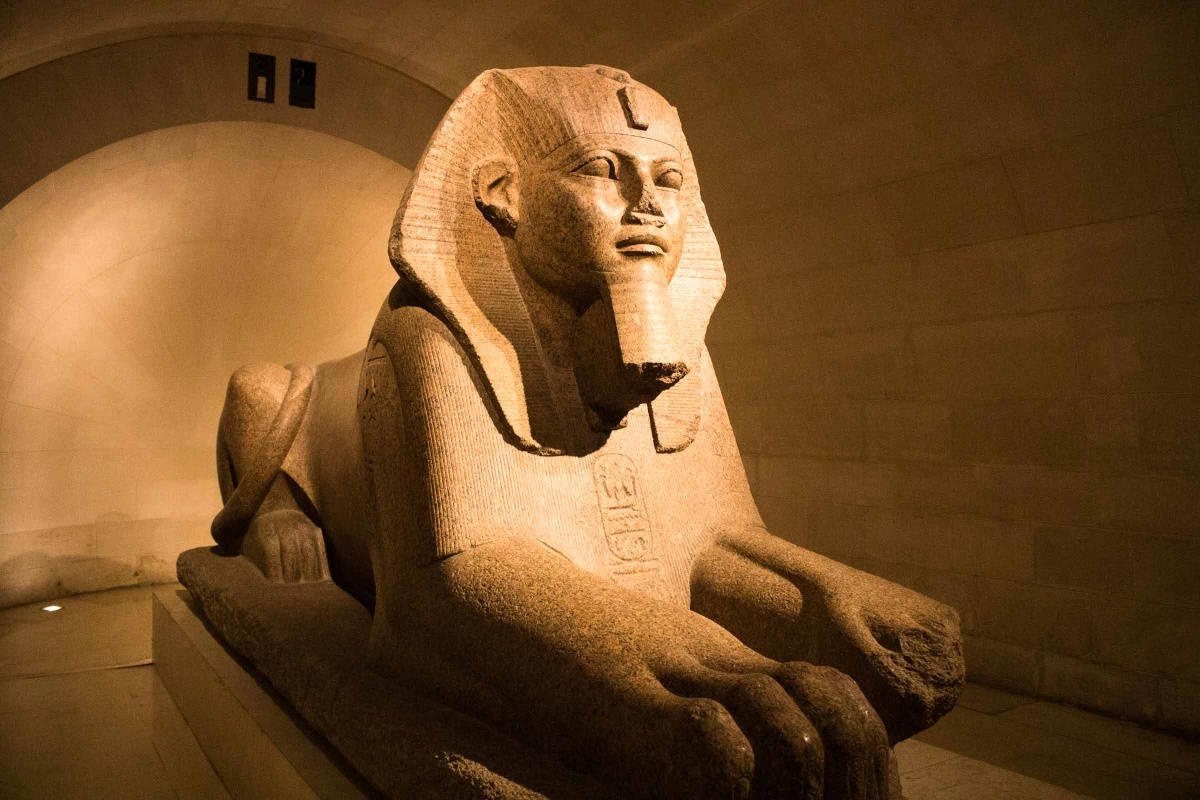
#7 Equestrian Statue of Louis XIV by Gian Lorenzo Bernini
This monumental equestrian statue of King Louis XIV of France is a remarkable example of Baroque sculpture. The statue captures the king in a dynamic pose on horseback, symbolizing his power and authority.

3. Decorative Arts in The Louvre Paris
Discover ornate furniture, intricate tapestries, and exquisite porcelain pieces that offer insights into different eras and cultures.
The Louvre Museum in Paris is not only celebrated for its impressive collection of paintings and sculptures but also for its extensive collection of decorative arts.
These objects, spanning various historical periods and regions, offer a fascinating glimpse into the craftsmanship, design, and cultural influences of different eras.The Louvre's collection of decorative arts is a testament to human creativity, craftsmanship, and cultural exchange over centuries.
Whether you're interested in the opulence of royal courts, the simplicity of everyday life, or the global influences on design, the decorative arts at the Louvre offer a rich and diverse exploration of the art of ornamentation and design throughout history. Here's an overview of the decorative arts at the Louvre:
Furniture
The museum's collection of furniture is a testament to the evolution of design and craftsmanship throughout history. It includes exquisite pieces from various European countries, showcasing different styles such as Rococo, Neoclassical, and Art Nouveau. You can find ornate cabinets, luxurious chairs, and elegant tables that reflect the tastes and trends of their respective periods.
Porcelain and Ceramics
The Louvre's collection of porcelain and ceramics encompasses a wide range of pieces, including delicate porcelain vases, intricately painted ceramics, and decorative plates from various cultures. This collection provides insights into the art of pottery and the cultural exchanges that occurred through trade and diplomacy.
Textiles and Tapestries
The museum boasts an extensive textile collection featuring sumptuous textiles, tapestries, and carpets from different historical periods and regions. These textiles not only showcase intricate weaving techniques but also depict scenes from mythology, history, and daily life.
Glassware
The glassware collection at the Louvre includes exquisite glass objects, from delicate stained glass windows to colorful glass vases. These pieces demonstrate the mastery of glassblowing and the artistic significance of glass in architecture and decorative arts.
Decorative Objects
The Louvre also houses an array of decorative objects, such as clocks, candelabras, and ornamental items crafted from various materials like bronze, silver, and precious metals. These objects highlight the craftsmanship and artistic ingenuity of their creators.
Jewelry
The museum's collection of jewelry is a dazzling display of adornments from different periods, including ancient civilizations and European royalty. Intricately designed necklaces, tiaras, and brooches reveal the evolving styles and societal trends related to personal adornment.
Decorative Arts from Other Cultures
In addition to European decorative arts, the Louvre also features decorative objects and artifacts from around the world. These items offer insights into the artistry, traditions, and customs of diverse cultures, making the Louvre a global repository of decorative arts.
Decorative Arts in Period Rooms
Some areas of the museum recreate period rooms, allowing visitors to step back in time and experience the ambiance of specific historical periods. These rooms are adorned with furniture, textiles, and decorative objects that transport visitors to different eras.
4. Egyptian Antiquities in The Louvre Paris
The Louvre Museum in Paris is home to one of the most extensive and remarkable collections of Egyptian antiquities outside of Egypt itself. These treasures span millennia, providing a glimpse into the rich history, culture, and mythology of ancient Egypt. The Egyptian antiquities at the Louvre not only showcase the artistic achievements of this ancient civilization but also shed light on their religious beliefs, social structure, and daily life.
It's a testament to the enduring fascination with Egypt's rich heritage, and a visit to this section of the museum offers a captivating journey through the mysteries and wonders of the Nile Valley. Here's an overview of the Egyptian antiquities housed in the Louvre:
Sphinx of Tanis
As mentioned above, one of the most iconic pieces in the Egyptian collection at the Louvre is the colossal Sphinx of Tanis. This granite statue, dating back to the 26th Dynasty (around 600 BCE), is a stunning example of Egyptian sculpture and a symbol of royal power.
Egyptian Jewelry
The museum's collection includes a vast array of Egyptian jewelry, such as intricately crafted necklaces, bracelets, and amulets. These pieces are not only exquisite examples of ancient craftsmanship but also serve as insights into the importance of jewelry in Egyptian society, often worn for both adornment and protective purposes.
Mummies and Sarcophagi
The Louvre boasts a collection of mummies and beautifully decorated sarcophagi, providing a window into the ancient Egyptian beliefs about the afterlife. These artifacts often contain inscriptions and depictions of gods and goddesses, hieroglyphics, and scenes from the deceased's journey to the afterlife.

Statues and Reliefs
The museum is home to a vast array of statues and reliefs from different periods of Egyptian history. These sculptures depict pharaohs, gods, and everyday people, reflecting the artistic and religious traditions of the time.
Book of the Dead
The Louvre also houses sections of the "Book of the Dead," a collection of spells and illustrations that ancient Egyptians believed would guide the deceased through the afterlife. These papyrus scrolls provide invaluable insights into ancient Egyptian beliefs about death and the afterlife.
The Seated Scribe
This sculpture, crafted during the Old Kingdom, is a notable piece in the collection. It depicts a scribe in a seated position, exemplifying the ancient Egyptian emphasis on naturalistic representation and the significance of scribes in their society.
Rosetta Stone Replica
While the original Rosetta Stone is in the British Museum, the Louvre displays a replica. The Rosetta Stone was crucial in deciphering Egyptian hieroglyphs, as it contains inscriptions in three scripts: Greek, demotic, and hieroglyphic.

The Louvre's Egyptian Antiquities Wing
The Egyptian collection at the Louvre is housed in a dedicated wing that replicates the layout of an Egyptian temple. Visitors can explore this space, complete with hieroglyph-covered walls and monumental statues, to immerse themselves in the atmosphere of ancient Egypt.
5. Near Eastern Antiquities in The Louvre Paris
The Louvre Museum in Paris houses an impressive collection of Near Eastern antiquities that provides a captivating glimpse into the history, art, and cultures of the ancient Near East. This diverse and extensive collection spans several millennia and includes artifacts from various civilizations that once thrived in the region. Visiting the Near Eastern antiquities section of the Louvre is like embarking on a journey through time and space, exploring the remarkable civilizations that once thrived in this region. It provides a deeper understanding of the cultural, religious, and societal achievements of the ancient Near East, making it a must-visit for history enthusiasts and art lovers alike.
Here is an overview of the Near Eastern antiquities at the Louvre:
Mesopotamian Artifacts
The Louvre's collection of Near Eastern antiquities features a rich assortment of artifacts from ancient Mesopotamia, including items from the Sumerian, Akkadian, Assyrian, and Babylonian civilizations. Highlights include cuneiform tablets, cylinder seals, and monumental stone reliefs that depict scenes from the epic of Gilgamesh, religious rituals, and royal conquests.

The Code of Hammurabi in The Louvre Paris
One of the most famous artifacts in the Louvre's Near Eastern collection is the Code of Hammurabi. This ancient legal code, dating back to around 1754 BCE, is inscribed on a tall, black diorite stele. It represents one of the earliest known examples of written law and provides insights into the legal and social systems of ancient Babylon.
Persian Artifacts
The museum also houses artifacts from the Achaemenid Persian Empire, including ornate jewelry, pottery, and sculptures. These pieces reflect the opulence and grandeur of Persian art and culture during the height of the empire.
Phoenician and Levantine Artifacts
The collection includes objects from the Phoenician city of Tyre, known for its seafaring and trade. Visitors can see Phoenician sarcophagi, jewelry, and sculptures. Additionally, the museum houses artifacts from the Levant, shedding light on the ancient cultures that inhabited this region.
Ancient Anatolian Artifacts
The Louvre's Near Eastern collection also features artifacts from ancient Anatolia, including Hittite sculptures and inscriptions. These relics provide valuable insights into the Hittite civilization, one of the great powers of the ancient Near East.
Assyrian Winged Bulls
Monumental sculptures of winged bulls with human heads, known as Lamassu, are prominent features in the museum. These colossal figures once guarded the entrances of Assyrian palaces and temples and are iconic representations of Assyrian art and power.
Ancient Near Eastern Jewelry and Adornments
The collection includes an array of intricately designed jewelry, adornments, and decorative objects from various ancient Near Eastern cultures. These items reflect the craftsmanship and aesthetic preferences of their respective societies.
Near Eastern Steles and Tablets
The Louvre houses a significant number of steles and tablets with inscriptions in cuneiform script. These inscriptions document historical events, religious texts, and administrative records, offering invaluable historical and linguistic insights.
6. Islamic Art in The Louvre Paris
The Louvre Museum in Paris is home to a rich and diverse collection of Islamic art that spans over a millennium and covers a vast geographical area, from Spain to India and beyond. The Islamic art collection in the Louvre offers visitors a fascinating insight into the artistic, cultural, and scientific achievements of Islamic civilizations, on the journey through the rich tapestry of Islamic civilization. It highlights the extraordinary artistic achievements and cultural diversity of the Islamic world and underscores the museum's commitment to preserving and showcasing the global heritage of art and culture.Here's an overview of the Islamic art at the Louvre:
Islamic Architecture
The collection includes architectural elements such as intricately designed doors, windows, and wall panels from various Islamic regions. These pieces showcase the stunning geometric patterns, intricate calligraphy, and decorative motifs often seen in Islamic architectural design.
Islamic Calligraphy
Islamic calligraphy holds a special place in the art and culture of the Islamic world. The Louvre's collection features beautifully executed examples of calligraphy, including Quranic verses and poetic inscriptions, demonstrating the mastery of Arabic script.
Ceramics
The Louvre has an extensive collection of Islamic ceramics and pottery. Visitors can admire pieces like vibrant Persian tiles, exquisite Iznik ceramics from Turkey, and intricately decorated pottery from North Africa. These items showcase the range of styles and techniques employed in Islamic pottery.

Textiles and Carpets
The collection includes an array of Islamic textiles, carpets, and textiles. These items often feature intricate patterns, including floral motifs and calligraphic elements. The textiles on display represent different Islamic dynasties and regions.
Metalwork and Woodwork
The Louvre's collection of Islamic metalwork and woodwork includes finely crafted objects such as astrolabes, candlesticks, and doors adorned with intricate geometric patterns and arabesques. These artifacts highlight the technical expertise and artistic innovation of Islamic artisans.
Manuscripts and Miniatures
The museum houses a significant number of Islamic manuscripts and miniatures, which include beautifully illustrated Qurans, scientific texts, and literary works. These manuscripts are not only artistic treasures but also valuable sources of historical and scientific knowledge.
Islamic Scientific Instruments
The Louvre's collection features various Islamic scientific instruments, including astrolabes and celestial globes. These instruments reflect the significant contributions of Islamic scholars to fields such as astronomy and mathematics during the medieval period.
Islamic Decorative Arts
The museum also houses a range of decorative arts, including Islamic glassware, metalwork, and jewelry. These items provide insights into the everyday lives and customs of Islamic societies.
Islamic Artifacts from Al-Andalus
The collection includes objects from Al-Andalus (Islamic Spain), an area known for its unique blend of Islamic, Christian, and Jewish cultures. These artifacts illustrate the cultural exchanges that occurred during this period.
7. Greek, Etruscan, and Roman Antiquities
Greek Antiquities
The Greek antiquities housed in the Louvre Museum provide a window into the classical world that has shaped Western civilization. The collection encompasses a wide range of objects, including sculptures, pottery, and jewelry. Among the most notable pieces is the Venus de Milo, a striking marble statue of Aphrodite, the Greek goddess of love and beauty. Created in the 2nd century BC, this masterpiece is celebrated for its graceful pose and exquisite craftsmanship.
Another iconic sculpture is the Winged Victory of Samothrace, a magnificent Hellenistic masterpiece representing the goddess Nike. The sculpture, dating from the 2nd century BC, conveys a sense of dynamic movement and triumph, making it a symbol of victory and grandeur.
In addition to sculptures, the Louvre's Greek collection boasts an impressive array of vases and ceramics. The red-figure pottery, showcasing intricate scenes from Greek mythology and daily life, provides valuable insights into the culture and beliefs of ancient Greece.

Etruscan Antiquities
The Etruscans, an ancient Italian civilization that predates the Roman Empire, left behind a unique and enigmatic legacy. The Louvre's Etruscan collection offers a glimpse into their distinctive culture, art, and customs. One of the most striking artifacts is the Sarcophagus of the Spouses, a sculpted tomb from the 6th century BC. This funerary piece features a couple reclining together, offering a poignant portrayal of Etruscan beliefs about the afterlife and the importance of family bonds.
Etruscan jewelry, such as gold bracelets and intricate hairpins, demonstrates their skill in metalwork and their penchant for adornment. These artifacts reflect the Etruscans' appreciation for aesthetics and their status-conscious society.
Roman Antiquities
The Roman Empire, one of the most influential civilizations in history, is well-represented in the Louvre's collection. Roman antiquities on display include sculptures, mosaics, and architectural fragments. Among the highlights is the famous statue of Emperor Augustus, known for its idealized depiction of the ruler and its historical significance.
The Louvre also houses a section of the ancient Roman city of Lutetia (the precursor to modern Paris). Visitors can explore the remains of Roman baths, temples, and housing, gaining insights into daily life in Roman Gaul.
One of the most remarkable Roman artifacts in the museum is the Borghese Gladiator, a marble statue that captures the intensity and athleticism of gladiatorial combat. This sculpture is a testament to the Romans' fascination with sports and their appreciation for physical prowess.
8. Prints and Drawings in The Louvre Paris
The Louvre Museum in Paris is not only renowned for its extensive collection of paintings and sculptures but also for its impressive collection of prints and drawings. This collection, often referred to as the Department of Prints and Drawings, is a hidden gem within the museum, housing a vast and diverse array of works on paper that span centuries and encompass various artistic styles.
The Department of Prints and Drawings at the Louvre is a treasure trove of artistic expression and creativity. It offers a unique opportunity to explore the world of art beyond the canvas and the sculpture, allowing visitors to appreciate the skill, innovation, and historical significance of works on paper. Whether you're a seasoned art enthusiast or a casual visitor, this collection provides a fascinating and often overlooked dimension of the Louvre's cultural richness.

Historical Overview
The Department of Prints and Drawings at the Louvre has its origins in the royal collections, with some of the earliest acquisitions dating back to the reign of Louis XIV. Over the centuries, the collection has grown significantly, and it now comprises over 200,000 works on paper.
European Masters
The collection features works by some of the most celebrated European artists, including Leonardo da Vinci, Michelangelo, Raphael, Rembrandt, and Albrecht Dürer. These drawings and prints offer an intimate look into the creative process and artistic development of these masters.
French Art
The Department of Prints and Drawings also boasts an extensive selection of French art, showcasing works by iconic French artists such as Jacques-Louis David, Eugène Delacroix, and Edgar Degas. These pieces provide insights into the evolution of French art over the centuries.
Old Masters
The collection includes drawings and prints from the Renaissance and Baroque periods, featuring artists like Titian, Rubens, and Caravaggio. These works are invaluable for studying the techniques and aesthetics of these influential art movements.
Decorative Arts
In addition to fine art, the Department of Prints and Drawings at the Louvre houses a collection of decorative arts drawings, including designs for furniture, textiles, and ornamental objects. These drawings reveal the intersection of art and design in various historical periods.
Studies and Sketches
Many of the drawings in the collection are studies and sketches created by artists as they developed ideas for larger works. These sketches provide a unique window into the thought processes and creative experimentation of artists.
Manuscripts and Illustrated Books
The department also houses illuminated manuscripts and illustrated books, showcasing the artistry of medieval and Renaissance bookmakers. These manuscripts often feature intricate illustrations and calligraphy.
Changing Exhibitions
The Louvre regularly organizes temporary exhibitions highlighting specific themes or artists within the prints and drawings collection. These exhibitions offer visitors the opportunity to explore different aspects of this rich and diverse collection.
Sculptures of the Middle Ages, Renaissance, and Modern Times in The Louvre Paris
The Louvre Museum in Paris is a treasure trove of medieval, Renaissance and modern sculpture. Each period represents distinct artistic movements and styles. Its sculptures not only reflect the evolving aesthetics of each period, but also provide a deep insight into the cultural, political and religious context that shaped these works of art. Exploring this diverse collection is a journey through the changing nature of sculpture and a testament to the enduring power of human creativity across the ages. Here's an overview of the sculptures from these epochs at the Louvre:
Middle Ages
Romanesque Sculpture
The Louvre Paris houses a remarkable collection of Romanesque sculptures, which date from the 10th to the 12th centuries. These sculptures often adorned churches and cathedrals, featuring stylized figures with elongated proportions and intricate decorative elements. Notable examples include the capitals from the Abbey Church of Saint-Denis.
Gothic Sculpture
The transition to Gothic art brought about more naturalistic and graceful sculptures. The Louvre's collection includes exquisite examples of Gothic sculpture, including statues and reliefs from cathedrals like Chartres and Reims. The "Virgin and Child" by Jean de La Huerta is a particularly renowned piece.
Renaissance
Italian Renaissance Sculpture
The Renaissance period, known for its revival of classical art and humanism, is well represented at the Louvre. Visitors can admire sculptures by Italian masters like Michelangelo's "Slaves" and Antonio Canova's "Psyche Revived by Cupid's Kiss." These works demonstrate a keen understanding of anatomy and a desire to capture the beauty of the human form.

French Renaissance Sculpture
French sculptors of the Renaissance, such as Jean Goujon and Germain Pilon, are also prominently featured in The Louvre Paris. Pilon's "Funeral Monument of Henri II and Catherine de' Medici" is an exceptional example of Renaissance sculpture blending religious and royal symbolism.
Modern Times
Neoclassical Sculpture
The Neoclassical period, marked by a return to classical themes and forms, is represented by sculptures like Jean-Antoine Houdon's "Diana the Huntress" and Antoine-Denis Chaudet's "Cupid and Psyche." These works exemplify the Neoclassical emphasis on idealized beauty and harmonious proportions.
19th and 20th Century Sculpture
The Louvre's collection includes sculptures from the 19th and 20th centuries, showcasing the evolution of artistic styles during this period. Auguste Rodin's "The Age of Bronze" and "The Burghers of Calais" are iconic pieces that capture the emotional and expressive qualities of sculpture in this era.
Contemporary Sculpture
The Louvre has expanded its collection to include contemporary sculptures, reflecting the museum's commitment to showcasing evolving artistic trends. Visitors can encounter works by artists like Alberto Giacometti, Henry Moore, and Louise Bourgeois.
The Louvre Paris Experience: Architecture and Ambiance
The museum's architecture is a fusion of various styles and historical layers, and its ambiance exudes an unparalleled sense of history, culture, and artistic grandeur.
The Louvre's architecture and ambiance are a testament to the enduring power of human creativity, reflecting the evolving tastes, values, and aspirations of society over the centuries. Whether you are an art enthusiast, a history buff, or a casual visitor, a visit to the Louvre promises an unforgettable journey through time and culture in one of the most iconic settings in the world.
As you step into the Louvre's grand courtyard, the iconic glass pyramid designed by architect I.M. Pei commands attention. This modern addition contrasts beautifully with the historic architecture, seamlessly merging the past and present. The Louvre's vast exhibition spaces, ornate ceilings, and elegant galleries create an immersive environment that enhances the art-viewing experience.
Architectural Evolution
The Louvre's architecture is a testament to the evolving tastes and needs of the French monarchy and society. Originally a royal palace, the Louvre was built in the late 12th century as a medieval fortress. Over the centuries, it underwent multiple expansions and renovations, each reflecting the prevailing architectural trends of its time.
Medieval and Renaissance Architecture: The medieval fortress, known as the Louvre Castle, was transformed during the Renaissance into a grand palace by King Francis I. The addition of the Cour Carrée (Square Courtyard) and the Francis I Wing brought Renaissance architectural elements to the Louvre Paris.
Subsequent monarchs, including Louis XIV and Louis XVI, made significant contributions to the palace's architecture. The Louvre's central axis and façade facing the Seine River showcase the grandeur of French Baroque and Neoclassical architecture.
In the 1980s, the Louvre underwent a modern transformation with the construction of the iconic glass pyramid entrance designed by architect I. M. Pei. This contemporary addition seamlessly blends with the historical architecture and symbolizes the museum's commitment to embracing both tradition and innovation.
Ambiance and Atmosphere in The Louvre Paris
The Louvre's ambiance is a unique blend of history, artistry, and cultural significance. When visitors enter its grand halls and galleries, they are enveloped in an atmosphere that is both awe-inspiring and intimate.
Walking through the Louvre is like stepping back in time. The grandeur of the palace, with its ornate ceilings, elaborate frescoes, and opulent chandeliers, evokes the splendor of France's royal past.
The museum's architectural design incorporates numerous courtyards and light wells that allow natural light to filter into the galleries. This balance of light and shadow enhances the viewing experience of the artworks and creates a tranquil ambiance.
The Louvre's galleries are organized in a way that guides visitors on a chronological and thematic journey through art history. From the ancient civilizations of Egypt and Mesopotamia to the grandeur of European painting, the Louvre offers an immersive and educational experience.
The Tuileries Garden, adjacent to the Louvre, offers a serene escape from the bustling city. Visitors can stroll through the meticulously landscaped gardens, admire sculptures, and enjoy beautiful vistas of the Louvre's historic façade.
Cultural Significance
The Louvre's architecture and ambiance go beyond aesthetics; they hold immense cultural significance. As one of the world's largest and most visited museums, the Louvre embodies the universality of art and culture. It serves as a symbol of France's rich artistic heritage and its commitment to preserving and sharing this heritage with the world.
The Tuileries Garden adjacent to The Louvre Paris
The Tuileries Garden, located adjacent to the Louvre Paris, is a stunning and historically significant garden that offers a serene oasis amid the bustling city.
The Garden is not only a place of natural beauty but also a testament to the enduring artistry of landscape architecture. Its role as a tranquil retreat within the heart of a bustling metropolis makes it a cherished destination for both locals and tourists, offering a moment of respite and appreciation for the timeless beauty of Paris.

The Tuileries Garden's history is closely intertwined with the French monarchy. It was originally created by Queen Catherine de' Medici in the 16th century and was later expanded and redesigned by André Le Nôtre, the renowned landscape architect who also designed the Gardens of Versailles. The name "Tuileries" comes from the tile factories (tuileries in French) that previously occupied the site.
André Le Nôtre's design of the Tuileries Garden reflects the classical French formal garden style. The garden is characterized by symmetrical parterres, gravel paths, neatly trimmed hedges, and strategically placed statues. The geometric layout creates a sense of order and harmony, while reflecting pools and fountains add a touch of tranquility. The garden is adorned with numerous sculptures, both classical and contemporary. Visitors can admire works by artists like Aristide Maillol and Auguste Rodin, whose famous sculpture "The Thinker" graces one end of the garden. These sculptures blend seamlessly with the garden's aesthetics, creating an open-air art gallery.
The Garden provides a welcome respite for both locals and tourists. Many Parisians and visitors come here to relax, read, picnic, or simply enjoy a leisurely stroll. The park's numerous green chairs, placed strategically throughout, invite visitors to sit and soak in the beauty of the surroundings.
In spring, the garden comes alive with blossoming flowers, including tulips and cherry blossoms. In summer, the manicured lawns are perfect for sunbathing and picnics. Autumn brings a symphony of colors to the trees, and in winter, the stark beauty of the garden's architecture is on full display.
The garden often hosts cultural events, including outdoor concerts, art exhibitions, and fashion shows. These events add to the garden's vibrancy and contribute to its role as a cultural hub in Paris.
From the Tuileries Garden, visitors can enjoy breathtaking views of some of Paris's most iconic landmarks. The Eiffel Tower, Place de la Concorde, and the Louvre's majestic façade are all visible from different vantage points within the garden.
One of the great features of the Tuileries Garden is its proximity to the Louvre. Visitors can seamlessly transition from the beauty of the garden to the world-class art housed in the museum.
The Allure of the Louvre Paris at Night
As the sun sets over the City of Light, the Louvre takes on a magical aura, offering a unique opportunity to experience its treasures under a different light. The museum's evening hours allow visitors to explore its galleries and exhibitions with fewer crowds, creating an intimate and enchanting atmosphere.
The illuminated pyramid, the glistening Seine River nearby, and the intricate architectural details come together to create an unforgettable nighttime ambiance. One of the most captivating aspects of the Louvre Paris at night is its architectural beauty, which is accentuated by subtle lighting. The grand façade of the Louvre Palace, with its intricate carvings and majestic columns, takes on an ethereal glow under the soft illumination. As you step into the courtyard, the Cour Carrée, you are greeted by the tranquil sound of fountains gently splashing in the moonlight. Inside the museum itself, the Louvre's treasures take on a new dimension. The galleries are bathed in a soft, golden light that casts an enchanting aura over the artworks.

Paintings and sculptures, from ancient to contemporary, are imbued with a sense of mystique, drawing you into their stories and emotions. The Mona Lisa, perhaps the most famous painting in the world, seems to come alive in the dim light, her enigmatic smile even more enigmatic.You can sit in front of a painting for as long as you like, allowing it to speak to your soul. It's a rare opportunity to connect with art on a deeply personal level.
It's a reminder that some experiences are best savored in the quiet hours when the world sleeps, and the Louvre comes alive in a way that is both magical and unforgettable.
Prioritize Must-See Artworks in the Louvre Paris
The Louvre Museum in Paris is a treasure trove of art and history, housing an extensive collection that can be overwhelming to navigate. To make the most of your visit, it's helpful to prioritize must-see artworks. Remember that the Louvre is vast, and it's impossible to see everything in one visit. Prioritizing these must-see artworks and areas can help you make the most of your time and leave you with a profound appreciation for the art and history within its walls.While personal preferences may vary, here's a list of some iconic pieces and areas within the Louvre that many visitors consider essential:
- Mona Lisa (La Gioconda): Undoubtedly, Leonardo da Vinci's "Mona Lisa" is the Louvre's most famous attraction. It's housed in a climate-controlled, bulletproof glass case in the Denon Wing. Expect crowds, but it's a must-see for its enigmatic smile and historical significance.
- Venus de Milo: This ancient Greek sculpture of Aphrodite, the goddess of love and beauty, is a masterpiece of classical art. Its elegant pose and missing arms have intrigued viewers for centuries.
- Winged Victory of Samothrace (Nike of Samothrace): Perched dramatically at the top of the Daru Staircase, this Hellenistic sculpture of Nike, the goddess of victory, is a symbol of triumph and grace. Its dramatic pose and flowing drapery are breathtaking.
- Liberty Leading the People: Delacroix's iconic painting depicting Liberty as a female allegorical figure leading the French people during the July Revolution of 1830 is a powerful work of Romantic art.
- The Wedding Feast at Cana (Le Mariage de Cana): Painted by Veronese, this colossal artwork on the wall of the Louvre's Salle des États portrays the biblical miracle of turning water into wine. It's a testament to the grandeur of Renaissance art.
- The Raft of the Medusa (Le Radeau de la Méduse): Géricault's dramatic and emotionally charged painting depicts the survivors of a shipwreck adrift at sea. It's a monumental work of Romantic art that conveys the resilience of the human spirit.
- Napoleon III Apartments: Explore the sumptuously decorated apartments that once belonged to Napoleon III and Empress Eugénie. These opulent rooms provide a glimpse into the extravagant lifestyle of the French imperial court.
- The Crown Jewels: Don't miss the opportunity to view the impressive French Crown Jewels, including the dazzling Regent Diamond and the ornate crowns and scepters of French monarchs.
- Egyptian Antiquities: The Louvre's Egyptian collection is one of the largest and most comprehensive in the world. Explore the ancient artifacts, mummies, and the renowned Great Sphinx of Tanis.
- Islamic Art Collection: Visit the Department of Islamic Art to explore a diverse range of Islamic artworks, including ceramics, textiles, manuscripts, and architectural elements.
- French Sculpture Courtyard: The Cour Marly and Cour Puget house an incredible collection of French sculpture, including works by Rodin and Canova, displayed amidst beautiful courtyard settings.
- The Great Gallery (Galerie d'Apollon): Admire the magnificent ceiling painted by Charles Le Brun and the stunning display of crown jewels and royal regalia in this grand gallery.
- Decorative Arts: Explore the decorative arts collection in the Richelieu Wing, which includes exquisite furnishings, porcelain, and intricate period rooms.
- Medieval Louvre: Visit the medieval section of the museum, where you can see remnants of the original Louvre fortress and learn about the museum's history.
- Enjoy the Louvre's Architecture: Take time to appreciate the Louvre's architectural beauty, including the glass pyramid entrance and the surrounding courtyards.
The Louvre Paris for Kids: Making Art Education Fun
The Louvre can be an exciting and educational adventure for young minds. The Louvre is not just a museum filled with ancient artifacts and priceless artworks; it's a playground of imagination waiting to be explored by curious young minds. By incorporating storytelling, interactivity, and creative activities, the Louvre can become an enchanting place for kids to discover the wonders of art and history. So, plan your next family trip to the Louvre, and watch as your children embark on a journey of art education that's as fun as it is informative.

Storytelling Tours
One of the best ways to introduce kids to art at the Louvre is through storytelling tours. Imagine wandering through the magnificent halls while a guide weaves captivating tales about the artworks. These stories can make the art come alive, connecting with children on a personal level. It's like stepping into a fairy tale filled with knights, princesses, and mythical creatures.
Interactive Exhibits
Kids love to get hands-on, and the Louvre has interactive exhibits designed just for them. These exhibits often encourage children to touch, feel, and interact with replicas or digital versions of famous sculptures and artifacts. It's a fantastic way for kids to experience art in a tactile manner.
Scavenger Hunts
Turn your visit into a thrilling treasure hunt! Create a list of artworks or objects for kids to find within the museum. For example, you could challenge them to locate the Mona Lisa's enigmatic smile or the imposing Winged Victory of Samothrace. This not only keeps kids engaged but also helps them explore the entire museum.
Art Workshops in The Louvre Paris
The Louvre frequently offers art workshops tailored to different age groups. Here, kids can become budding artists themselves. They can try their hand at painting, sculpture, or other artistic techniques under the guidance of skilled instructors. It's a fantastic opportunity for children to unleash their creativity.
Digital Learning
In the digital age, the Louvre has embraced technology to engage kids. Many museums, including the Louvre, have interactive apps and websites that provide information about the artworks in a fun and informative way. These apps often include games, quizzes, and augmented reality features that make learning about art an adventure.
Thematic Tours
For older kids with specific interests, the Louvre offers thematic tours. These tours focus on particular aspects of art, such as ancient Egypt, Renaissance masterpieces, or sculptures. Tailoring the visit to a child's interests can make the experience more engaging and relevant.
Art Detective
Transform your kids into art detectives on a mission! Give them magnifying glasses and notebooks and challenge them to uncover hidden details in the artworks. This activity encourages careful observation and critical thinking, making the museum visit both educational and enjoyable.
Exploring the Louvre's Gardens
When you think of the Louvre Museum in Paris, you might envision its world-famous art collections, iconic glass pyramid entrance, or the breathtaking architecture of the museum itself. However, nestled amidst the grandeur of this historic institution lies a serene and often overlooked treasure—the Louvre's enchanting gardens.
The Jardin des Tuileries and the Carrousel Garden offer a delightful blend of art, history, and nature in the heart of Paris. So, the next time you visit the Louvre, be sure to set aside some time to explore these charming green oases. You'll find that they are not just a complement to the museum but an integral part of the Louvre's enchanting allure.
The Louvre's garden adventure begins with the Jardin des Tuileries, an exquisite formal French garden located just outside the museum's wings. Originally commissioned by Queen Catherine de' Medici in the 16th century, these gardens were designed in the Italian Renaissance style. They served as a playground for French royalty and eventually opened to the public in the 17th century.
As you step into the Jardin des Tuileries, you'll be greeted by a symphony of meticulously manicured trees, fountains, and statues. The garden is adorned with sculptures by renowned artists like Auguste Rodin and Aristide Maillol. For kids and adults alike, it's like taking a leisurely walk through an open-air art gallery.

Towards the Louvre's eastern end, you'll discover a lovely rectangular pond called the Grand Bassin Rond. Here, children can delight in sailing toy boats, a popular pastime in the garden. In the summer, small cafes set up along the pond, offering refreshments and a chance to bask in the sun's warmth.As you meander through the Jardin des Tuileries, you'll be treated to captivating vistas of the Louvre's stunning façade. The garden's careful design allows for magnificent views of the museum's architectural splendor, particularly the Denon Wing and the iconic glass pyramid entrance.
Connected to the Jardin des Tuileries is the Carrousel Garden, which is just as enchanting but often less crowded. This garden is named after the nearby Carrousel Arch, which was built to celebrate Napoleon's military victories. It's an ideal spot for a leisurely picnic or to simply soak up the peaceful atmosphere.The Louvre occasionally hosts outdoor art exhibitions in its gardens, adding a contemporary twist to this historic space. These installations provide a unique opportunity for kids and adults to engage with art in a more relaxed and open-air setting.In the bustling heart of Paris, the Louvre's gardens offer a tranquil escape.
Whether you're visiting with family, seeking a quiet moment amidst the city's hustle and bustle, or simply looking for a place to rest your feet after exploring the museum, the Louvre's gardens provide a welcome respite.
A Culinary Delight: Dining at the Louvre
The Louvre offers a range of dining options that allow you to savor delicious French cuisine while surrounded by artistic splendor.Dining at the Louvre is not just about satisfying your hunger; it's an integral part of the overall experience. Whether you're seeking a gourmet meal with a view, a quiet retreat, a sweet treat, or a casual picnic, the Louvre offers a variety of culinary options to suit every taste and budget.
So, as you plan your visit to this world-renowned museum, remember to savor the culinary delights it has to offer. After all, indulging in delicious French cuisine amidst centuries of art is an experience you won't soon forget.
Le Café Marly: A Palatial Setting
Imagine enjoying a gourmet meal with a view of the Louvre's iconic glass pyramid and the beautiful Cour Napoléon courtyard. That's precisely what you can expect at Le Café Marly, a restaurant known for its elegant atmosphere and prime location. The restaurant's terrace offers a picturesque backdrop for your meal, making it an ideal spot for a leisurely lunch or a romantic dinner.
Lunch at Le Fumoir: A Relaxing Retreat
If you're looking for a tranquil escape, Le Fumoir is the place to be. This chic restaurant, tucked away in the Denon Wing of the museum, offers a respite from the bustling crowds. With its contemporary design and a menu featuring French classics with a modern twist, it's the perfect spot to recharge during your Louvre adventure.
Café Richelieu – Angelina: A Sweet Treat
For those with a sweet tooth, Café Richelieu – Angelina is a must-visit. Angelina is renowned for its decadent hot chocolate, and you can pair it with their famous Mont-Blanc pastry. This charming café, located in the Richelieu Wing, allows you to indulge in a sweet and satisfying break before or after exploring the museum's treasures.
La Cour Carrée: Al Fresco Dining
On a sunny day, dining al fresco in La Cour Carrée, the museum's historic square courtyard, is a delightful experience. You'll find a range of casual dining options, including cafes and bistros, offering everything from salads and sandwiches to French specialties like croque-monsieur. It's an ideal choice for families looking for a quick bite.
Picnicking in the Gardens: A Casual Option
If you prefer a more relaxed dining experience, consider packing a picnic and enjoying it in the Louvre's gardens. The Jardin des Tuileries, located just outside the museum, is a popular spot for picnicking. Grab some French cheeses, a baguette, and a bottle of wine, and savor your meal amidst the serene greenery.
Contributions to Art Scholarship
The Louvre Museum in Paris isn't just a repository of world-class art; it's also a significant contributor to the field of art scholarship. Through research, publications, exhibitions, and educational programs, the Louvre plays a pivotal role in advancing our understanding of art and culture. Is not just a passive custodian of art; it is a dynamic hub of art scholarship.
The Louvre's galleries cover 652 300 square metres, or nearly 15 hectares! The galleries contain around 7,500 paintings, 66% of which are by French artists.
Its contributions extend beyond its stunning galleries and into the realm of research, education, and conservation. By continuously pushing the boundaries of art scholarship, the Louvre ensures that art remains a living, evolving field of study that enriches our understanding of the world's cultural heritage.
Research and Conservation in The Louvre Paris
The Louvre boasts an extensive research department dedicated to studying its vast collection. Experts in art history, conservation, and scientific analysis work tirelessly to uncover hidden details in artworks, understand their historical context, and preserve them for future generations. These efforts result in groundbreaking discoveries and contribute to the broader knowledge of art history.
Publications and Catalogs
The Louvre consistently produces scholarly publications and catalogs that accompany its exhibitions. These catalogs are invaluable resources for art historians, students, and enthusiasts worldwide. They provide in-depth analyses of the artworks on display, shedding light on their origins, significance, and cultural context.
Exhibition Programming
The Louvre regularly organizes exhibitions that push the boundaries of art scholarship. These exhibitions often feature rare loans from other institutions and present fresh perspectives on well-known artists or periods. They inspire further research and dialogues within the art community.
Educational Initiatives
The museum's educational programs are designed to engage scholars, students, and the general public. The Louvre offers lectures, seminars, workshops, and guided tours, providing access to experts who share their knowledge and insights. These programs foster a deeper appreciation for art and encourage academic pursuits.
Interdisciplinary Research
The Louvre encourages interdisciplinary research by collaborating with scholars from various fields such as history, archaeology, anthropology, and sociology. These collaborations result in holistic understandings of artworks and their cultural significance.
Digital Initiatives
The Louvre has embraced technology to enhance art scholarship. Its online databases, digital archives, and virtual tours enable researchers from around the world to access the museum's collection and conduct remote research. This accessibility has democratized art scholarship and expanded its reach.
Conservation Techniques
The Louvre is at the forefront of developing innovative conservation techniques. By studying and restoring artworks, conservators gain insights into artistic processes and materials used throughout history. These insights contribute to the broader field of art conservation.
International Collaborations
The Louvre actively collaborates with museums and institutions worldwide, fostering international dialogues and knowledge exchange. Such collaborations enrich the global understanding of art and culture.
Conservation Efforts: Preserving Art for Future Generations
The Louvre's commitment to preserving art for future generations is evident through its extensive conservation efforts. Experts work tirelessly to restore and maintain artworks, ensuring that they remain in pristine condition. The museum's conservation labs are a testament to the dedication required to safeguard humanity's artistic heritage.

Ensuring the preservation of these priceless artworks for future generations is a monumental task, one that the Louvre takes very seriously.hrough a combination of expert knowledge, cutting-edge technology, and a commitment to ethical practices, the Louvre ensures that these priceless artworks remain a source of inspiration and education for generations to come. These conservation efforts not only protect the past but also ensure that the art of the Louvre continues to enrich the future.
Skilled Conservators: At the heart of the Louvre's conservation efforts are its team of highly skilled conservators. These experts are trained in various disciplines, from painting and sculpture restoration to paper and textile conservation. Their meticulous work involves cleaning, repairing, and stabilizing artworks to prevent deterioration.
Cutting-Edge Technology
The Louvre utilizes state-of-the-art technology to aid in conservation efforts. Advanced imaging techniques, such as infrared and ultraviolet photography, reveal hidden details and layers in artworks. Scientific analysis helps conservators better understand the materials used by artists and detect any structural issues.
Preventive Conservation
Prevention is often the most effective form of conservation. The Louvre employs preventive measures, including controlled climate and humidity levels in its galleries, to protect artworks from environmental damage. It also carefully monitors the handling and transportation of artworks to minimize the risk of damage.
Research and Documentation
The Louvre's conservation teams conduct extensive research on the materials and techniques used in its artworks. This research informs conservation decisions and contributes to the broader field of art conservation. Detailed documentation ensures that the history of each artwork's treatment is preserved for future reference.
Restoration Studios
The Louvre has dedicated restoration studios equipped with the necessary tools and equipment. These studios are often open to the public, allowing visitors to witness the painstaking work of conservators and gain a deeper appreciation for the art preservation process.
Conservation Ethics
The Louvre adheres to strict ethical guidelines in its conservation efforts. Conservationists strive to strike a delicate balance between preserving an artwork's historical integrity and ensuring its longevity. They avoid over-restoration, opting for minimal intervention to maintain the authenticity of the piece.
Public Awareness
The Louvre recognizes the importance of educating the public about art conservation. Through exhibitions, workshops, and educational programs, the museum raises awareness about the challenges of preserving art and engages visitors in the conservation process.
Collaborations
The Louvre often collaborates with other institutions and conservation experts to tackle complex restoration projects. These collaborations bring together a wealth of knowledge and resources to ensure the best possible outcomes.
Emergency Response
The Louvre has robust emergency response plans in place to protect its collection during unforeseen events like natural disasters or accidents. These plans include strategies for evacuating artworks, safeguarding against water damage, and minimizing risks.
Conservation in Action
Visitors to the Louvre can witness conservation efforts firsthand, as some artworks are displayed in various stages of restoration. This transparency helps demystify the conservation process and emphasizes the museum's commitment to preserving art.
Tips and Tricks for a Memorable Visit
The Louvre Museum in Paris is a vast and awe-inspiring institution, home to thousands of artworks and historical treasures. By following these tips and embracing the rich culture and history within the Louvre's walls, you'll create a memorable and enriching experience that will stay with you long after your visit.To make the most of your visit and create lasting memories, consider these helpful tips:
- Plan Ahead: Start by planning your visit in advance. Decide which sections or artworks you want to see most, and check the Louvre's website for opening hours, ticket prices, and any special exhibitions. Consider purchasing tickets online to avoid long lines at the entrance.
- Arrive Early: The Louvre is a popular destination, and crowds can be significant, especially in the afternoon. Arriving early when the museum opens will give you a quieter, more enjoyable experience and a chance to see famous works with fewer people around.
- Stay Hydrated and Wear Comfortable Shoes: The Louvre is massive, and you'll likely be doing a lot of walking. Bring a water bottle to stay hydrated, and wear comfortable shoes to ensure you can explore without discomfort.
- Use a Map: The Louvre can be a maze, so pick up a map at the entrance or download one from the museum's website. It will help you navigate the museum's various wings and locate specific artworks.
- Consider a Guided Tour: Joining a guided tour can be an excellent way to get insights into the artworks and history of the Louvre. Guides can help you focus on the highlights and provide valuable context.
- Take Breaks: Don't try to see everything in one visit. The Louvre can be overwhelming, so take breaks to rest and reflect. There are plenty of seating areas and cafes where you can relax.
- Don't Rush the Mona Lisa: The Mona Lisa is undoubtedly a star attraction, but be prepared for crowds. Rather than rushing to the front, take your time to appreciate the painting from a distance, allowing you to see its details and smile without the jostling.
- Explore Lesser-Known Areas: While the Louvre's famous artworks are a must-see, don't forget to explore some of the lesser-known sections of the museum. You might stumble upon hidden gems and artworks that resonate with you personally.
- Respect Photography Rules: The Louvre has specific rules about photography in its galleries. Generally, you can take photos without flash, but it's essential to respect the signs and guidelines posted in each room.
- Visit the Louvre's Gardens: Take a break from the art and enjoy the Louvre's beautiful gardens, such as the Jardin des Tuileries. It's a serene oasis in the heart of Paris and a great place for a picnic or a leisurely stroll.
- Learn About the Art: Before your visit, read about some of the key artworks you want to see. Understanding their historical context and significance can enhance your appreciation during your visit.
- Use the Louvre App: Download the Louvre's official app, which provides maps, visitor information, and multimedia guides. It can be a valuable tool for navigating the museum and learning more about the artworks.
- Respect the Art and Environment: The Louvre is home to irreplaceable treasures. Follow museum rules, such as not touching artworks or leaning on displays. Also, be mindful of noise levels, as loud conversations can disrupt others' experiences.
- Enjoy the Architecture: The Louvre's architecture itself is a masterpiece. Take time to admire the stunning courtyards, historic wings, and the famous glass pyramid.
- Reflect and Immerse: Finally, take moments to immerse yourself in the art and history of the Louvre. Stand before an artwork, reflect on its beauty and significance, and let the magic of the museum wash over you.
- Bags: Small bags are allowed, but larger bags and luggage must be deposited at the museum's cloakroom. This is to ensure the safety of the artworks and other visitors.
- For people with disabilities: The Louvre is committed to accessibility. The museum offers facilities and services to accommodate visitors with disabilities, including accessible entrances, ramps, and elevators.
- It's worth booking online and arriving early in the morning so you don't have to queue for long periods of time and you can fit everything you plan in because, although you can't see it, there's a huge area to cover.
- Plan for the whole day
- Find the back entrance! There you can get in in a few minutes with your pre-booked tickets. Address: Carausel du Louvre, 99 Rue de Rivoli shop at street level, then take the escalator down to the lower level and you'll find it there! So you can spend an hour or an hour and a half in the museum looking around!
- The bag or jacket can be placed in a numbered locker free of charge
- It's worth buying a ticket for several days, because you can visit more than just the Louvre Museum.
- It's worth planning in advance which themes you're going to run into, what you're really interested in, because there's absolutely no chance of running through the whole collection even if you're there from opening to closing without stopping.
- You can buy your ticket online for an appointment.
- Go to the Museum at night. It is open Wendsday and Friday nights until 9:45 pm and is much less crowled. From Oktober to March, access to the permanent collections is free on the first Sunday of each month.
Special rules for photohraphers in The Louvre Paris
Photographing the artworks and architecture of the Louvre Museum can be a delightful experience for photographers. However, it's important to be aware of and follow the museum's rules and guidelines to ensure a respectful and enjoyable visit.

By adhering to these rules and guidelines, photographers can enjoy their visit to the Louvre while helping to preserve the artworks and ensure a pleasant experience for all visitors. Remember that the primary focus should always be on appreciating the art and history within the museum. Here are the key rules for photographers at the Louvre:
- No Flash Photography: Flash photography is strictly prohibited in the Louvre. The intense bursts of light can cause significant damage to delicate artworks and can fade pigments over time. So, always disable your camera's flash function.
- Respect Artworks and Barriers: Maintain a respectful distance from the artworks and never touch them. The Louvre often places barriers or ropes to indicate where visitors should stand. Always abide by these boundaries.
- Tripods and Monopods: In general, the use of tripods and monopods is not allowed within the museum. The additional setup time and space required can obstruct the flow of visitor traffic and create safety hazards. Exceptions are made for professional photographers with prior authorization. Use high ISO instead.
- Photography Permitted in Most Areas: While there may be specific restrictions for temporary exhibitions or particular artworks, photography is generally allowed in most areas of the Louvre. This includes the permanent collection galleries and the museum's architecture.
- Respect Other Visitors: Be mindful of other visitors while taking photographs. Avoid blocking pathways, entrances, or exits, and be considerate of fellow art enthusiasts who may want to view the artworks without distractions.
- No Selfie Sticks: The use of selfie sticks is generally not allowed inside the Louvre. These devices can pose a risk to the safety of artworks and other visitors.
- Commercial Photography and Filming: If you intend to conduct commercial photography or filming (including documentaries, advertisements, or promotional work) within the Louvre, you must obtain prior authorization and permits from the museum's administration. Additional fees may apply.
- Use Silent Mode: Set your camera to silent or vibration mode to minimize noise disruptions. Loud camera clicks can be distracting to other visitors and disturb the peaceful atmosphere of the museum.
- Be Aware of Special Exhibitions: If you plan to photograph special exhibitions or temporary displays, check for any specific rules or restrictions that may apply to those areas. Some exhibitions may have different photography policies.
- No Tripods in Courtyard Areas: Tripods are generally not allowed in the Louvre's courtyard areas, including the Cour Carrée and Cour Napoléon. These spaces are often crowded, and tripods can create obstacles.
- Respect Museum Staff: Always comply with instructions given by Louvre staff or security personnel. They are there to ensure the safety of visitors and the protection of the artworks.
- No Drones: The use of drones for aerial photography or filming is strictly prohibited within the Louvre's premises and its immediate vicinity.
Opening hours
The Louvre is typically open from 9 a.m. to 6 p.m. on most days, except Tuesdays. On Wednesdays and Fridays, the museum extends its hours until 9:45 p.m.
Site location: 75001 Paris
GPS coordinates: 48.861132, 2.335356
Google Photos: Click here
For more content and exciting articles, follow our site, where we regularly update our column to bring you the best ideas for events or things to do in Paris!






